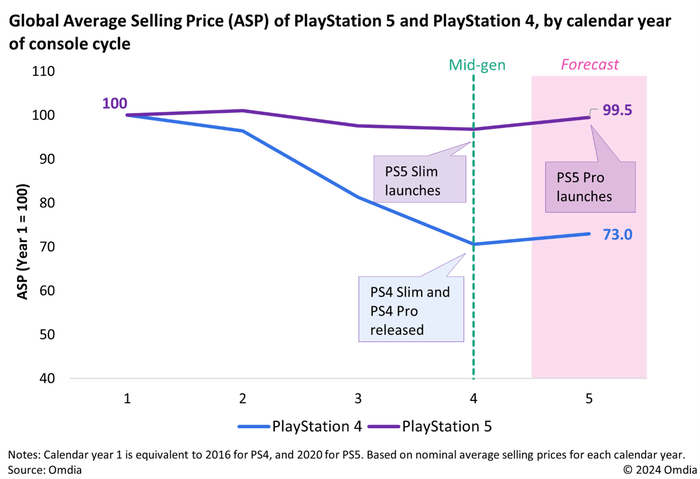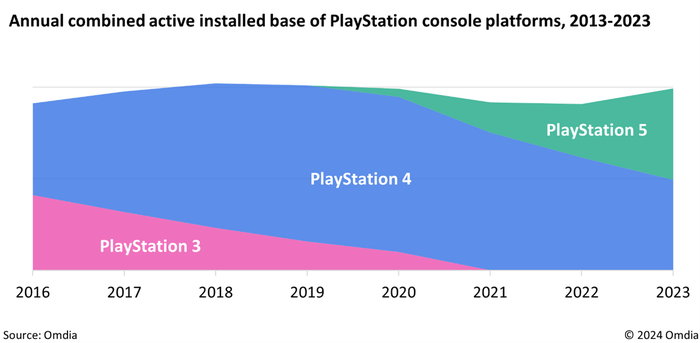The PlayStation 5 Pro will launch at just under $700, which is a 75% increase over both the nominal price of its last-gen predecessor, the PS4 Pro, and the 56% premium over the PS5 Digital Edition. For comparison, the PS4 Pro launched at the same launch price as the PS4.
While this makes the PS5 Pro’s price unprecedented for Sony, it’s not unexpected. Console manufacturers have historically released hardware at a lower price to accommodate price-sensitive latecomers, like 2016’s PS4 Slim ($100 less) and 2019’s Switch Lite ($100 less).
However, the cost per transistor has not dropped on key components like the CPU this generation. This has had a knock-on impact with the 4Q23 PS5 Slim hardware revision, which released at the same or higher price than the 2020 PS5, depending on the SKU and territory.
As a result, hardware ASPs for this generation to date have tracked higher than the previous generation (see Figure 1). Additionally, in 2024, Sony has de-emphasized its use of regular discounts as a means of increasing the PS5’s installed base in an effort to maintain the profitability of its hardware.
Figure 1: PS5 hardware ASP has remained significantly higher, generation after generation, than PS4

Source: Omdia Games hardware database
PS5 Pro is aimed squarely at PlayStation's most engaged audience
The PS5 Pro’s $700 price tag makes it an aspirational device, aimed at gamers who want the best experience possible. In the past, platform holders have catered to this small but highly engaged audience with niche systems adjacent to popular home console platforms, such as the 1991 Neo Geo AES ($649 or $1,502 in real terms) and the 1993 3DO ($699 or $1,512 in real terms).
The difference today is that the premium “Pro” consoles are mid-generation upgrades, meaning they’re on top of what are already thriving console platforms. In the case of the PS5 Pro, it will still sit alongside an active installed base of PS4, PS4 Pro, and PS5 gamers, whose software and services boast significant interoperability.
Figure 2: Pro consoles accounted for just 13% of the combined PS4 and Xbox One install base by the end of 2019

Source: Omdia Games hardware database
It’s not even the first of its kind: Sony has already had a string of successes with the PS4 Pro. Omdia data reveals that just 1.8 million PS4 Pro systems were sold in its launch year, 2016. By the end of its fourth calendar year on the market, 2019, the 13.9 million PS4 Pro units sold accounted for less than 15% of the overall PS4 install base.
Likewise, Omdia's historical console hardware data reveals that Microsoft's equivalent, the Xbox One X, also accounted for just over 10 percent of consoles installed in the same time frame. Together, both “Pro” machines accounted for just over 13 percent of the PlayStation 4 and Xbox One console installed base (see Figure 2).
Despite the PS4 Pro’s relatively competitive price, then, it has always been an enthusiast device, in stark contrast to previous mid-generation upgrades like the Game Boy Color, DSi, and New Nintendo 3DS. And Sony has usage data on PS4 and PS5 players that will have identified a large enough and highly engaged segment of its audience that would make the PS5 Pro a worthwhile venture.
Figure 3: Total addressable market among PlayStation consoles largely static generation over generation

Source: Omdia Games Addressable Market Metrics Database
It is this engagement that is key to understanding Sony’s strategy with the PS5 Pro. With the active installed base of PlayStation users remaining static across the generation transition (see Figure 3), Sony has focused its attention on increasing spending over the console lifecycle. This has materialized in the following ways:
The PS5 Pro is another way for Sony to appeal to a highly engaged audience or allow them to self-select into the PlayStation ecosystem.
And yet, despite the above, Omdia doesn’t expect the PS5 Pro to sell in the same volumes as its predecessor. The PS4 Pro not only launched at a relatively lower price point, but it coincided with the adoption of 4K TVs reaching critical mass. It also launched simultaneously with PlayStation VR, a more compelling platform than its current-gen successor, the PS VR 2.
PS5 Pro Won't Be Enough to Reverse PS5 Sales Decline in 2024
As the PS5 approaches its fifth full year on the market without a single permanent price drop, the lack of major first-party blockbusters throughout 2024, coupled with a prolonged intergenerational gap, has led the PS5 to enter its decline phase a year earlier in its cycle than the PS4.
Omdia’s preliminary console forecast estimates that even in a best-case scenario, PlayStation 5 sales volumes would still decline by 17% in 2024 compared to 2023.
At the moment, the PlayStation 5 Pro is set to launch alongside the casual-friendly console Lego Horizon Adventureswhich is currently the only confirmed first-party title scheduled for the holidays. By comparison, the PS4 Pro launched in close proximity to fan-favorite AAA first-party games like Uncharted 4, The Last Guardian, AND Gravity Race 2.
The PS5 Pro is also arriving in a development landscape where the gestation period for AAA games is longer and more expensive than the previous generation. This has resulted in a sustained period of cross-generation in the PS5 cycle, with publishers only recently starting to abandon last-gen systems for their AAA games. However, at the same time, 2024 has also been a quiet year for such major releases.
However, Sony has the opportunity to exploit the halo effects created by Grand Theft Auto 6, which is scheduled for release in 2025. The game is expected to launch exclusively on console platforms, with a PC release expected at least a year later. That would leave the PlayStation 5 Pro as the best place to experience what is one of the most anticipated games of the modern era. If Sony is smart, it should strike a marketing deal with publisher Take-Two to promote the game alongside its new console.
The PS5 Pro will prove to be an interesting case study for the console market, thanks to its notable contrast to its predecessor, the PS4 Pro. That older system was a defense strategy against the mobile baseline of PC gaming hardware and a response to the adoption of 4K TVs.
Meanwhile, the PS5 Pro is focused on an audience that wouldn’t think twice about switching to PC. But at its $700 price point, the stakes will be high for the PS5 Pro to deliver a tangible advantage to this audience in the three to four years before Sony begins its transition to the PS6, especially in a generation that has shipped fewer blockbuster exclusive games than the previous one.